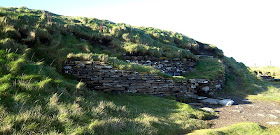
Skelday
My gg grandfather on my mom’s side was born in Birsay, Orkney, a fertile farming area. He was born in 1814 but I am having trouble finding the names of his parents since there does not seem to be a Parish record of his birth date or christening date. I will have to look into this further in Edinburgh. Anyway, gg grandfather gave an oral history to a granddaughter in 1899 or 1900 and in that history he said he was born on the Hillside of Birsay in the house called Skelday.
They name the farms in Orkney and the names have remained the same over the years, the farms are even on the map. Today John and I went to visit the farm Skelday. A young farmer was cleaning out the barn with his tractor when we drove in so he stopped. I told him what we were doing so he said we should go into the house to talk to his dad. The dad’s g grandfather purchased Skelday in 1868 and he knew that Spences had lived on that farm in the past but did not know which ones, there were a lot of Spences in Birsay.
The current farmers of Skelday are very friendly people so we talked about farming and whatnot. They are beef farmers, raising Angus as they bring in a premium price and they only drive JD tractors which is hilarious. The majority of their cattle are shipped by boat to Aberdeen so it makes it bit more expensive to raise cattle on Orkney. The prices have improved the last few years for them. He feeds silage and grows barley, I asked how they ever get the barley off with all the rain they get, they take it at 18 minimum and up to 25 moisture. The young guy had a wicked accent so he was difficult to understand but he said something about putting something in the barley to inhibit mould.
When John went to take a few pics of the farm the farmer gave me a tour of the barn, he had just weaned the calves so it was a bit of a racket.



Highland Park Distillery
In the afternoon we went to Highland Park Distillery for a tour. They are one of the few distilleries who malt their own barley but certainly not all of it. We visited the malting floor where the sprouted barley lays and they have a machine that drives over the barley and turns it so it does not clump together and rot. The barley looked okay, they claim all of their barley comes from Scotland as the barley grown in Orkney is not of a high enough quality. They use heather-root peat and coke in the kiln to dry and smoke the barley, the barley then takes on the smoky flavour of the peat. When they make the mash or what the hell ever it is, non-peaty barley is blended with their own to give a less peaty taste. The end result is aged in used sherry barrels from Spain. They gave us 15 year old to taste but it is a lighter and a less tasty whisky than the whisky I had with dinner the other night.
This is our last night in Orkney and it is windy and raining. Tomorrow we leave for the north of Scotland and I don’t know if we will have internet access tomorrow night.




























































